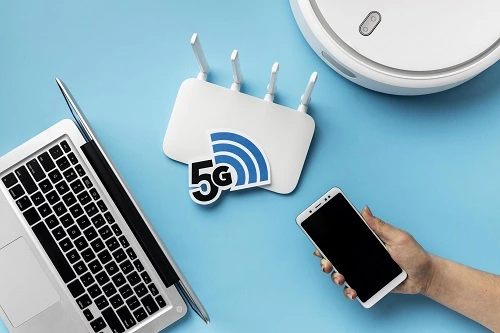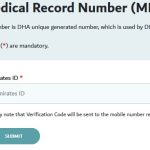DU Broadband, a leading provider of telecommunications services, offers a range of broadband connections tailored to meet the diverse needs of customers in 2023. In this article, we’ll explore the various types of DU Broadband connections available, their features, advantages, and how to choose the right one for your specific requirements.

Types of DU Broadband Connections
A. Fiber-Optic DU Broadband
Fiber-optic DU broadband is a cutting-edge internet connection technology that has gained immense popularity for its impressive benefits. Here, we will explore the specifics of Fiber-Optic DU Broadband, focusing on its benefits, availability and coverage, as well as speed and performance:
Benefits of Fiber-Optic DU Broadband
Fiber-optic DU broadband stands out due to several key advantages:
- Exceptional Speed: Fiber-optic technology allows for the transmission of data using light pulses through thin strands of glass or plastic. This results in incredibly fast internet speeds. In fact, it’s not uncommon to experience speeds of up to 1 Gbps with Fiber-Optic DU Broadband. This high-speed capability makes it ideal for activities such as high-definition streaming, online gaming, and large file downloads.
- Low Latency: Latency refers to the delay between sending a request and receiving a response. Fiber-optic broadband typically has low latency, which is crucial for real-time applications like online gaming and video conferencing. With minimal lag, you can enjoy seamless interactions and responsive gameplay.
- Reliability: Fiber-optic connections are known for their reliability. Unlike traditional copper-based connections, they are less susceptible to interference from external factors like weather conditions or electrical interference. This reliability ensures a consistent and uninterrupted internet experience, even during peak usage times.
Availability and Coverage
While Fiber-Optic DU Broadband offers numerous benefits, its availability and coverage can vary:
- Urban and Suburban Areas: Fiber-optic broadband is widely available in urban and suburban regions. Major cities and densely populated areas typically have extensive coverage, allowing a significant portion of the population to access this high-speed technology.
- Limited Rural Coverage: Unfortunately, fiber-optic broadband coverage in rural areas may be limited. The installation of fiber-optic infrastructure is often cost-prohibitive in less populated regions, leading to a lack of availability in some rural communities.
- Expanding Networks: Telecommunication companies, including DU, are continuously expanding their fiber-optic networks to reach more areas. While rural coverage may still be a challenge, ongoing investments in infrastructure are gradually increasing the availability of Fiber-Optic DU Broadband.
Speed and Performance
Speed and performance are the hallmark features of Fiber-Optic DU Broadband:
- Blazing-Fast Speeds: As mentioned earlier, Fiber-Optic DU Broadband can deliver remarkable speeds of up to 1 Gbps. This speed is unmatched by most other broadband technologies and enables users to enjoy high-definition streaming without buffering, quick downloads, and smooth online gaming experiences.
- Consistent Performance: Fiber-optic connections provide consistent and symmetrical speeds, meaning that both upload and download speeds are nearly identical. This symmetrical performance is crucial for activities like video conferencing and uploading large files to the cloud.
- Low Latency: With low latency, Fiber-Optic DU Broadband ensures minimal delays in data transmission. This low-latency characteristic is particularly beneficial for online gamers and those who rely on real-time communication tools.
In summary, Fiber-Optic DU Broadband offers a multitude of advantages, including lightning-fast speeds, low latency, and reliability. However, its availability and coverage are more prevalent in urban and suburban areas, with efforts underway to expand access to rural regions. If you prioritize speed and performance for your internet needs, Fiber-Optic DU Broadband is an excellent choice, providing an exceptional online experience.
Read: DU internet speed test to understanding the performance of your potential internet connection.
B. DSL DU Broadband
DSL (Digital Subscriber Line) DU Broadband is a popular and accessible internet connection technology that many users rely on for their online needs. Let’s delve into the specifics of DSL DU Broadband, including its overview, advantages and limitations, and service plans and pricing:
Overview of DSL DU Broadband
DSL DU Broadband operates over traditional telephone lines and is known for its widespread availability. It uses a frequency range that allows both voice and data transmission to coexist on the same line simultaneously. Here’s an overview:
- Existing Infrastructure: DSL takes advantage of the existing telephone infrastructure, making it a cost-effective option for delivering internet access to homes and businesses.
- Digital Data Transmission: DSL technology converts digital data from your computer into signals that can be transmitted over copper telephone lines. This data is then received by a DSL modem at your location and converted back into digital form for your devices to use.
- Different Variants: DSL comes in various forms, such as ADSL (Asymmetric Digital Subscriber Line), VDSL (Very-High-Bit-Rate Digital Subscriber Line), and more. These variants offer different speeds and capabilities to suit different user requirements.
Advantages and Limitations
DSL DU Broadband has its own set of advantages and limitations:
Advantages:
- Affordability: DSL is often more budget-friendly compared to technologies like fiber-optic or cable broadband. This makes it a practical choice for individuals and households on a tight budget.
- Widespread Availability: DSL is available in many areas, including urban, suburban, and rural regions. It’s often the go-to option when faster technologies aren’t available.
- Stability: DSL generally provides a stable and reliable internet connection. It is less prone to signal interference compared to wireless options.
Limitations:
- Speed: DSL speeds can vary significantly depending on your location and the type of DSL technology used. While some areas may have access to faster DSL variants, others might experience slower speeds.
- Distance Matters: DSL performance degrades with distance from the telephone exchange or DSLAM (Digital Subscriber Line Access Multiplexer). The farther you are from the source, the slower your connection may become.
- Asymmetrical Speeds: In many DSL configurations, download speeds tend to be faster than upload speeds. This asymmetry can impact activities that require substantial upload bandwidth, such as video conferencing or uploading large files.
Service Plans and Pricing
DSL DU Broadband service plans and pricing can vary depending on the provider and region:
- Plan Variability: DU offers a range of DSL plans tailored to different user needs. These plans differ in terms of speed, data allowances, and additional services.
- Pricing: Pricing for DSL plans tends to be competitive. DU’s pricing structure typically reflects the selected plan’s speed and data limits.
- Bundling Options: Many internet service providers, including DU, offer bundling options that combine DSL internet with other services like home phone or television, often at a discounted rate.
- Contract Length: Service plans may come with different contract lengths, such as month-to-month or annual contracts. Contract length can also affect pricing.
In summary, DSL DU Broadband is a versatile and widely accessible internet technology that provides affordable and stable internet access. While it may not offer the fastest speeds available, it remains a dependable choice for many users, especially in areas where high-speed options are limited. When considering DSL, it’s essential to assess your specific speed requirements and check availability in your location to ensure it meets your needs.
Read: DU APN settings for steps to set APN for 3G, 4G, and 5G on Android and iPhone devices.
C. Wireless DU Broadband
Wireless DU Broadband is a versatile internet connectivity option that provides users with the freedom to access the internet without the constraints of physical cables. Let’s explore the key aspects of Wireless DU Broadband, including its introduction, the distinction between Mobile Broadband and Fixed Wireless, and DU’s offerings in this category:
Overview of Wireless DU Broadband
Wireless DU Broadband leverages wireless technology to deliver internet access to homes and businesses. Unlike traditional wired connections like DSL or fiber-optic, Wireless DU Broadband relies on radio waves for data transmission. Here’s an introduction to the topic:
- Wireless Connectivity: Wireless DU Broadband connects users to the internet through radio signals, allowing for a cordless and more flexible experience. It eliminates the need for physical cables running from the service provider’s infrastructure to the user’s location.
- Diverse Applications: Wireless broadband can serve a variety of purposes, from providing internet access to remote areas where wired connections are impractical to offering portable internet solutions for travelers or temporary setups.
- Scalable Solutions: Wireless broadband can be adapted to meet different speed and data requirements, making it suitable for both residential and business users.
Mobile Broadband vs. Fixed Wireless
Wireless DU Broadband encompasses two primary categories: Mobile Broadband and Fixed Wireless. Understanding the distinction between these two is essential:
Mobile Broadband:
- Portable Connectivity: Mobile broadband refers to internet access provided via cellular networks. Users can access the internet on the go through devices like smartphones, tablets, or portable hotspots.
- Flexibility: Mobile broadband offers high mobility and flexibility, making it an ideal choice for users who need internet connectivity while traveling or in locations without fixed infrastructure.
Fixed Wireless:
- Stationary Connectivity: Fixed wireless broadband provides internet access through a dedicated wireless link to a stationary receiver, typically an antenna or dish installed at the user’s location.
- Home and Business Use: Fixed wireless is suitable for both residential and business applications, particularly in areas where traditional wired broadband options are limited.
DU’s Wireless Broadband Offerings
DU, as a leading telecommunications provider, offers a range of Wireless DU Broadband solutions tailored to various user needs:
- Mobile Broadband Plans: DU provides mobile broadband plans designed for users who require internet access on the go. These plans often include options for data packages with varying limits to suit different usage patterns.
- Fixed Wireless Services: DU offers fixed wireless solutions for homes and businesses. This includes the installation of dedicated antennas or receivers at user locations, providing reliable and high-speed internet access without the need for traditional cables.
- Coverage and Speeds: DU’s wireless broadband offerings aim to provide extensive coverage, ensuring that users in various regions can access the internet. Speed options may vary depending on the technology and service package chosen.
- Device Compatibility: DU may offer a range of devices compatible with its wireless broadband services, such as 4G or 5G routers for home use or portable hotspots for on-the-go connectivity.
In conclusion, Wireless DU Broadband encompasses both Mobile Broadband and Fixed Wireless solutions, offering flexibility, mobility, and scalability. DU’s wireless broadband services cater to diverse user needs, from those who require internet access while traveling to those in areas with limited wired broadband options. When considering Wireless DU Broadband, users should assess their mobility requirements, speed needs, and the availability of DU’s wireless services in their location.
Read: DU Directory to explore a wide range of telecommunications options.
D. Satellite DU Broadband
Satellite DU Broadband is a specialized internet connectivity option that utilizes satellite technology to provide internet access to users, particularly in areas where traditional wired connections may be challenging to deploy. Here’s an in-depth look at Satellite DU Broadband, including Satellite Internet by DU, its pros and cons, and its significance in terms of rural coverage and accessibility:
Satellite Internet by DU
Satellite Internet by DU involves the use of geostationary satellites to facilitate internet communication between the user’s location and the satellite in orbit. Here’s an overview:
- Satellite Technology: In this setup, a satellite dish installed at the user’s premises communicates with a geostationary satellite orbiting the Earth. The satellite serves as a relay station, transmitting data signals between the user’s dish and the provider’s ground station.
- Global Reach: One of the primary advantages of satellite technology is its global reach. Satellite DU Broadband can provide internet access to remote and underserved areas where terrestrial infrastructure is lacking.
- Two-Way Communication: Satellite DU Broadband allows for two-way data communication, enabling users to both download and upload data from and to the internet.
Pros and Cons of Satellite Broadband
Satellite DU Broadband offers several advantages but also comes with some limitations:
Pros:
- Widespread Coverage: Satellite broadband can reach virtually any location with a clear line of sight to the satellite, making it a lifeline for rural and remote communities.
- Reliable Connection: Satellite broadband typically offers a reliable and consistent connection, irrespective of the user’s geographic location.
- Quick Deployment: Satellite services can be deployed relatively quickly, making them a valuable solution for disaster recovery or temporary internet needs.
Cons:
- Latency: Satellite connections often suffer from higher latency (delay) compared to terrestrial broadband. This latency can affect real-time applications like online gaming or video conferencing.
- Data Caps: Many satellite broadband plans come with data caps or Fair Access Policies that limit the amount of data a user can consume within a specific time frame.
- Weather Interference: Adverse weather conditions, such as heavy rain or snow, can temporarily disrupt satellite signals, affecting the quality of the connection.
Rural Coverage and Accessibility
Satellite DU Broadband plays a crucial role in addressing rural coverage and accessibility challenges:
- Rural Areas: Rural regions often lack the necessary infrastructure for traditional wired broadband options like DSL or fiber-optic. In such areas, satellite broadband provides a lifeline, connecting residents and businesses to the internet.
- Digital Divide: Satellite broadband helps bridge the digital divide by offering connectivity to underserved and remote communities. It allows rural residents to access online educational resources, telehealth services, and economic opportunities.
- Emergency and Disaster Response: In disaster-prone areas, satellite broadband is an invaluable resource for first responders, enabling them to establish communication quickly and efficiently during emergencies.
In summary, Satellite DU Broadband leverages satellite technology to provide internet access to users in remote or rural areas where traditional broadband infrastructure is limited. While it offers widespread coverage and reliability, it may have higher latency and data limitations. Nonetheless, it remains a critical tool for closing the digital divide and ensuring that even the most remote communities have access to the internet.
Conclusion
In 2023, DU Broadband offers a range of options to cater to the diverse internet requirements of individuals and businesses. Whether you need blazing-fast speeds, cost-effective connectivity, or rural coverage, DU has a broadband solution for you. Make an informed decision based on your location, speed needs, and budget to enjoy the benefits of a reliable DU Broadband connection.
Read also: DU Landline, to explore the benefits and features of a DU landline subscription to help you make the right choice for your connectivity needs.
FAQ
Is DU Broadband available nationwide in 2023?
DU Broadband coverage continues to expand, but availability may vary by location. Check their website for the latest information.
What are the advantages of fiber-optic DU Broadband?
Fiber-optic DU Broadband offers incredibly fast speeds, low latency, and is ideal for bandwidth-intensive activities like streaming and gaming.
Can I get wireless DU Broadband for my home?
Yes, DU offers wireless broadband options suitable for home use, providing flexibility and mobility.
Is satellite DU Broadband a good choice for rural areas?
Yes, satellite DU Broadband is a reliable choice for rural and remote areas where other broadband options may not be available.
How can I compare DU Broadband plans to find the best one for me?
DU provides a side-by-side comparison of their broadband plans on their website, making it easy to choose the right one based on your needs.






